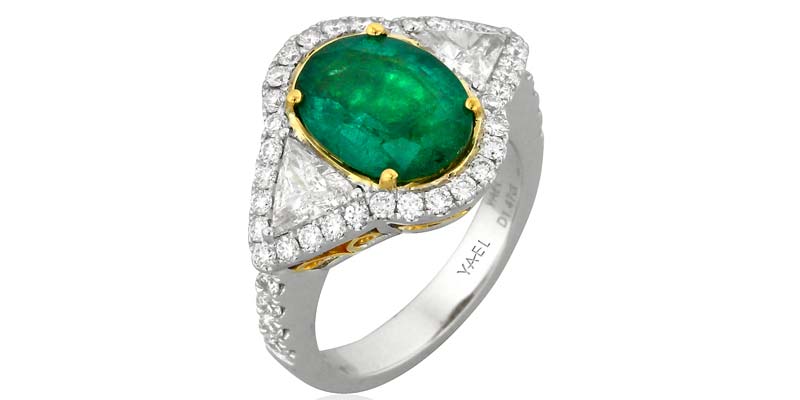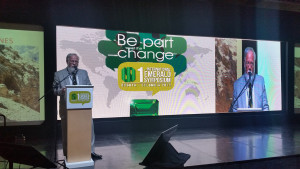Emerald speak: Colombia sets the scene for the First International Emerald Symposium
by jacquie_dealmeida | November 20, 2015 11:44 am
By Cynthia Unninayar
 [1]
[1]Organized by Fedesmeraldas—the Colombian Emerald Federation—with support from the country’s emerald-related bodies, including the governmental Ministry of Mines and Energy, the First International Emerald Symposium was held Oct. 13 to 15 in the nation’s capital city of Bogotá.
It was the first time producer countries have come together at a high-level global gathering to discuss issues relating to the emerald business. Many stakeholders in the international precious gemstone and jewellery industry attended, as well as governmental and private delegations from Zambia, Brazil, and Afghanistan. In attendance were also representatives of the major international trade organizations and laboratories, including:
• International Colored Gemstone Association (ICA);
• American Gem Trade Association (AGTA);
• World Jewellery Confederation (CIBJO);
• Instituto Brasileiro de Gemas e Metais Preciosos (IBGM);
• Gemological Institute of America (GIA)
• Asian Institute of Gemological Sciences (AIGS); and
• Gübelin.
Attracting some 200 local attendees and more than 150 international participants, speakers at the conference addressed many issues and concerns relating to the emerald trade, not only in Colombia, but around the world. Topics included resource management, traceability, ethics, manufacturing, treatments, certification, nomenclature, technology, consumer education, risks, security, marketing, and branding.
After the opening ceremonies, Maria Isabel Ulloa, vice-minister of mines, provided background on the Colombian emerald industry and how it is changing. Her main point dealt with the issue of transparency. “Currently some 63 per cent of mining activity is carried out without meeting legal requirements or paying taxes. We need to formalize the industry,” she said. “The Colombian emerald industry has reached a milestone and must be inclusive and competitive. International players are arriving and raising the bar for Colombia. We support them and our emerald industry must adapt to rigorous international standards.”
![Photo courtesy Cynthia Unninayar [Left to right] Jean Claude Michelou (moderator), Oscar Baquero (Fedesmeraldas), Gerry Manning (AGTA), Sean Gilbertson (Gemfields), and Charles Burgess (Muzo) at a discussion about theft and robberies in the mines.](http://www.jewellerybusiness.com/wp-content/uploads/2015/11/5-new-Group_4268-copy-3-300x179.jpg) [2]
[2]“Colombian emeralds are very much a gemstone of the present,” said Luis Gabriel Angarita, president of the Colombian Association of Emerald Exporters (ACODES). “Approximately two million carats worth $147 million U.S. were exported last year, mostly to North America.
Emeralds galore
Even though Colombia was the host nation, other significant emerald deposits around the world were topics of discussion. Gaston Giuliani, research director at the Institute for Research and Development (IRD), gave an overview of the major emerald deposits around the globe, while Gemfields executive director Sean Gilbertson spoke about emeralds in Zambia, currently the world’s largest emerald-producing nation. He also detailed the company’s involvement in modernizing the Kagem emerald mine in Zambia (where one gram of emerald is found for every five million grams of rock removed).
Gemmologist Warren Boyd, president of R.T. Boyd in Canada, provided an in-depth look at emerald mining in Russia. The world’s largest producer from 1830 to 1917, Russia today produces significant quantities of emeralds only from the Malyshev mine in the Urals. He explained Russian material is similar to gems from Colombia’s Cosquez mine, meaning a bright and light material.
 [3]
[3]Gary Bowersox, president of U.S.-based GeoVision, is an expert on Afghan emeralds. While the country continues in geopolitical turmoil, “its emeralds are world-class and rival those of Colombia and Zambia,” he said. On the other side of the planet, Brazil is the world’s third-largest producer of emeralds after Zambia and Colombia. Marcelo Ribeira, director of the Belmont mine located in Minas Gerais, stressed the company’s dedication to social and environmental responsibility.
Responsible mining
Corporate social responsibility (CSR) featured in many of the discussions. Charles Burgess, director of MinerÃa Texas Colombia, manages the strategic business and operations of the famed Muzo mine, formerly known as the Tecminas/Port Arthur mine that was owned by the infamous ‘Emerald Czar’ Victor Carranza. Burgess’s talk centred on the arrival of MTC at a time when the Colombian government was ready to modernize its emerald industry and raise it to international standards, along with promoting emeralds and encouraging CSR. Since acquiring the legendary mine six years ago, the Muzo companies have reportedly invested more than $50 million U.S. to modernize it with the latest mining extraction methods, technology-driven craftsmanship, transparency, mine-to-market traceability, and a safe and fair employment environment in the Boyaça region. Burgess added the Muzo companies provide more than 800 jobs, of which nearly 500 are in the communities surrounding the mine.
Jean Claude Michelou, the international co-ordinator of the symposium and co-chair of ICA’s Fair Trade and Ethical Mining Committee, reported on the traceability of coloured gems in general with an update on current initiatives and how the industry is moving forward. He stressed consumers want to have confidence in their purchases, which is helped by proper identification of gems and their origins, as well as the knowledge they are extracted in an environmentally friendly and ethical manner. “The global coloured gemstone industry accounts for $10 to $12 billion U.S. per year, with 80 per cent coming from small-scale informal mining. The supply chain from mine-to-market is extremely fragmented with a high degree of opacity.”
Sean Gilbertson, executive director of Gemfields, discussed the company’s CSR involving responsible mining and transparency initiatives against the backdrop of its policy of acquiring gem production around the world. Specifically, he described Gemfields’ involvement in modernizing the Kagem emerald mine in Zambia. He also spoke about developing ruby mining in Mozambique and other areas around the world. In addition, Gilbertson discussed the company’s recent move into Colombia with the purchase of 70 per cent of the Cosquez mine, one of Colombia’s major emerald-producing areas, and the acquisition of mining titles covering 20,000 hectares in the general Muzo and QuÃpama districts.
What’s in a name?
Branding expert, Dave Lightle, principal at U.S.-based VMA Worldwide, spent several years in Colombia, involved in branding efforts of the country itself, where he and his team changed the dialogue about the nation in the eyes of the world. He said emeralds teeter on commodity status. “They are not reining in the kind of value they should, due mainly to the lack of strong brand players in the global market.” Speaking specifically about marketing Colombian emeralds, he said the collective effort of “the local ‘mother gem’ brand is a good start, although it remains to be seen how it will be marketed. Also to be seen is the contribution of Gemfields and Muzo on branding Colombian emeralds.
The symposium also gave attendees a chance to network. Here, jewellery designer Erica Courtney looks at samples of emeralds from local emerald dealer, Amparo Valencia.
 [4]
[4]Discussing the importance of social media in marketing and branding was celebrity jewellery designer, Erica Courtney. She spoke at length about trends in gemstones and jewellery, and ways designers can use social media to increase brand awareness, getting the message across to both retailers and consumers.
The panel discussions drilled down on topics of crucial interest to the emerald community. The subject drawing the most, and sometimes contentious, comments revolved around nomenclature labs use when listing the degree of treatments for inclusions (e.g. minor, moderate, significant, etc.). Since the ‘normal’ state for most emeralds is to have moderate inclusions and thus moderate oil/resin/wax treatment, the suggestion by some was to change the ‘moderate’ designation to ‘normal.’ This would—many postulated—help salability. As is the case with other gemstones, namely sapphires and rubies, the terms used for the type of colour also incited lively debate, with some proposing descriptions other than or in addition to ‘vivid green,’ ‘intense green’ and others. No consensus was reached on either topic and the dialogue will, no doubt, continue for some time.
On a different note, concerns were raised about theft in the mines. In response, Burgess declared, “It is no secret robbery and theft are common along the supply chain. I am not talking about poor miners, but well-organized criminals in large-scale operations.” He referred to two deadly attacks on tunnels in the Muzo mine complex by well-armed thiefs, requiring the help of the police and military to quell the situation. The latest attack happened in May, when anywhere from 1000 to 3000 people (depending on different estimates) stormed the mine until police finally gained control. Losses were in the millions, with estimates ranging from $12 million to $42 million U.S.
As Gemfields’ begins its move into Colombia, Gilbertson stated they are learning a lot about conditions in the country, which are different from their operations in Zambia. Referring to the Kagem mine, he was very open in declaring Gemfields loses 15 per cent to 20 per cent of turnover due to internal theft. “Outside elements either pay or pressure mine workers to steal for them,” he said. “The stolen gems are then sold on the black market for less than their real value.” In a pragmatic approach to this problem, Gemfields buys back the gems on the black market, although it separates the repurchased stones from its other material. Oscar Baquero, president of Fedesmeraldas, summarized the situation, saying, “This is a complex issue and we need to have all channels open to solve the problem.”
A 20-year veteran of the jewellery and watch industry, Cynthia Unninayar travels the world reporting on the latest trends, promising new designers, global brands, and market conditions. Her interviews with some of the industry’s top players offer insight into what’s new and what’s happening on the global jewellery stage.
- [Image]: http://www.jewellerybusiness.com/wp-content/uploads/2015/11/main-emerald.jpg
- [Image]: http://www.jewellerybusiness.com/wp-content/uploads/2015/11/5-new-Group_4268-copy-3.jpg
- [Image]: http://www.jewellerybusiness.com/wp-content/uploads/2015/11/3-Gary-Bowersox-copy-2.jpg
- [Image]: http://www.jewellerybusiness.com/wp-content/uploads/2015/11/low-7_0058-copy.jpg
Source URL: https://www.jewellerybusiness.com/news/emerald-speak-colombia-sets-the-scene-for-the-first-international-emerald-symposium/